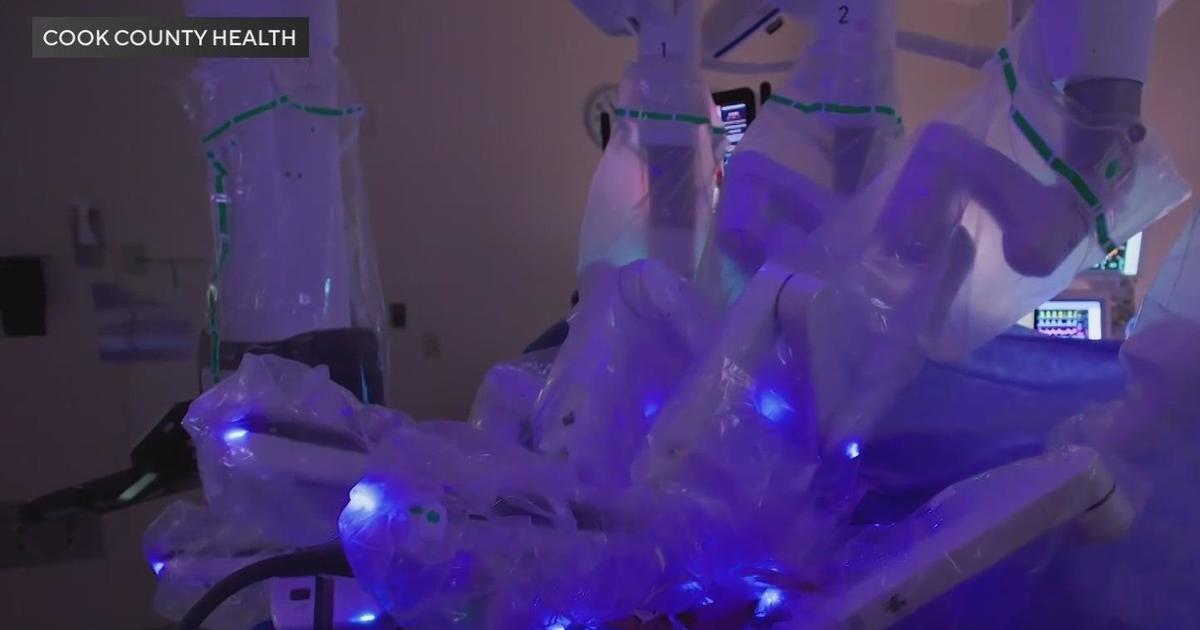"I Couldn't Do Nothing:" Cook County Jail Inmates Repeatedly Escape Restraints, Attack
By Suzanne Le Mignot and Christopher Hacker
CHICAGO (CBS) -- It's the middle of the afternoon in August 2018. Inmates at Cook County Jail are loaded onto buses — hands cuffed, chains around their waists — to be transported from the courthouse in south suburban Markham. The bus is quiet; inmates chat idly as they wait for their trip to start.
They have no idea this trip will end in a bloodbath.
About 15 minutes into the ride, an inmate stands up. The heavy chain around his waist now swings from his hands, free of the cuffs that once restrained him. He turns, walking slowly to the back of the bus.
Another inmate's words foreshadow what's to come: "Oh, you dead man!"
The inmate approaches another man standing at the back of the bus. He swings, hitting his still-restrained victim in the face.
He swings again. And again.
Another inmate, also free of his restraints, joins in. He flings the padlock on the end of the chain at the victim; blood pours from the man's face.
He's hit more than 20 times before finally breaking free. He runs to the front of the bus, but his attackers show no mercy. They follow, still swinging their chains, as another inmate yells, "Kill him! Kill him!"
This is not an isolated attack.
CBS 2 has uncovered at least seven incidents in the past 12 months in which inmates at the Cook County Jail are able to escape the restraints used during transport. Each of those incidents ended in violence, with escaped inmates attacking others who are still cuffed and unable to defend themselves.
In response to our investigation, the Sheriff's Office is already making changes. Sources tell CBS 2 certain high-risk inmates with histories of escaping restraints are now being transported under higher security procedures. And, the Sheriff's Office confirmed, "formal refresher trainings on restraints are set for the coming weeks for all officers handling transportation as well as others across the jail compound."
30 Miles of Violence
Click on each point on the map to see a clip of the inside of the bus at that location.
"That was the first time I ever got jumped on like that," said the victim in one of the incidents, 22-year-old Kimonte Cadge. "I couldn't even do nothing."
Cadge's still-visible scars tell the rest of the story.
One, on his right hand, is from trying to break out of his own restraints to protect himself. Another, a nearly three inch-long gash behind his left ear, is from being hit by the steel chains.
Surveillance video from inside the buses obtained by CBS 2 shows just how easy it is for these inmates to escape.
The restraints used during transportation have a chain which wraps around the waist, with a lock and handcuffs on one end. In one video, an inmate helps another pull the waist chain down around his ankles. In another, an inmate is able to simply pull his hand out of a cuff.
When the fights are over, the inmates are easily able to slip back into their chains, preventing authorities from determining who was responsible. And in one incident, a loose chain is used to choke one of the victims.
"That Should Never Be Able To Happen"
"The fact that it's a heavy lock and chain is by design," said David Olson, a professor of criminal justice and criminology at Loyola University Chicago. "It's intended to be something that can't be easily broken or gotten out of."
But, Olson said, Cook County has no choice but to use them.
"For brief periods of movement or transport, they can put someone in handcuffs, behind their back," Olson who specializes in prisons and jails said. "For longer periods of time, for reasons like [blood] circulation, that's not an appropriate way to restrain them."

An inmate helps another inmate escape his chains
Inmates need to move more freely while restrained for long periods of time, according to Olson. He said these restraints allow them to eat, drink and use the bathroom without needing to be uncuffed.
CBS 2 reached out to the manufacturer of these so-called "blue box" restraints, a company called CTS Thompson owned by Pennsylvania-based weapons manufacturer Combined Systems. They did not respond to several requests for comment.
When used properly, Olson said, the detainees should never be able to escape.
Instead, the inmates are able to use the steel chains and locks they've just escaped from as weapons. They swing the chains like whips, battering their helpless victims.
Victims like Cadge say Cook County shouldn't use those types of restraints at all.
"I've never seen a person, you know, pop out of regular handcuffs," Cadge said. "I've never seen it. The only thing I've seen is people pop off the blue box cuffs, how [Cadge's attacker] was in."
"The Bus Cannot Stop"
Cadge's attack lasted more than five minutes, according to surveillance video examined by CBS 2. Many attacks lasted much longer, with the longest incident lasting nearly 20 minutes on video.
That's because, sources told us bus drivers can't stop until backup arrives for safety reasons.
"The bus cannot stop on the highway at all," Cadge said. "There's nothing they can do, because they feel like it's a risk. And inmates, you know, in there fighting crazy cases, face crazy years, you know, they're going to try to escape."
Olson agreed. He said jail officials would do everything in their power to prevent attacks like this, but "if they were to stop the bus and 15 inmates escaped, the public would have a lot more concern about that, particularly if there's people that are on that bus that are facing serious charges."
That means, Cadge said, "You're going to be fighting, or get jumped on, all the way to the county [jail]."
An Expensive Problem
These attacks don't end when the buses stop. In at least three incidents, the victims later sued the county, alleging officials failed to protect them.
In 2016, a Cook Cook County jail detainee named Michael Reed was attacked while still restrained on a transport bus, he alleged in a lawsuit filed months later. In the suit, Reed said several inmates attacked the man to which he was chained. One inmate pulled out a homemade knife, the suit alleged, and stabbed Reed three times in the head and face, leaving his vision impaired.
Reed's suit was settled for an undisclosed amount in August 2017. But, a year later, another inmate would sue.
In that case, jail inmate Darryl Lloyd alleged he was attacked by another inmate who was "visibly not secured properly and able to easily free himself." Video of that incident obtained by CBS 2 shows an inmate kicking him in the head repeatedly before using his chains as a weapon.
A man kicks inmate Darryl Lloyd while he is stil restrained. Lloyd would later sue Cook County, alleging officials failed to protect him.
In his civil rights suit against the county, Lloyd demands more than $800,000 in compensation; the case is still pending. When we asked the Sheriff's Office how much has been paid out in total settlements due to these incidents, the sheriff's office didn't tell us.
"Impossible To Foresee?"
CBS 2 asked the Sheriff's Office for an on-camera interview with Cook County Sheriff Tom Dart, but they refused, saying the videos involved ongoing criminal investigations. Instead, they sent a written statement in which they described the incidents as "disturbing," but said transporting inmates poses a risk that is "impossible to foresee."
In the statement, a Sheriff's Office spokesperson told CBS 2 "hands-on training for the use of blue box restraints occurs daily" and "staff also receive refresher training on restraints when they are assigned to the transportation unit." But multiple sources with knowledge of the jail's procedures tell CBS 2 that isn't true.
Olson said training, as well as ensuring the equipment works properly, is critical to ensure these incidents don't happen.
"If it was a malfunction in a handcuff, that allowed it to be removed, that has to be checked," Olson said. "If it was a failure to use the equipment as it's intended or designed, there just need to be assurances that officers are using the equipment correctly."
The Sheriff's Office told CBS 2 they transport nearly 400 inmates each weekday, with hundreds of trips to and from courthouses each year. But, Olson said, "once the staff are in a routine where they're doing this hundreds of times a day, with hundreds of individuals, day in and day out, you could understand how there could be mistakes that occur."
Those mistakes, Olson said, shouldn't be underestimated.
"Hopefully people see this for what it is," Olson said. "It's somebody being physically assaulted. Some may discount it, because they're both charged with crimes and perhaps some people would view that as a less deserving group to have some concern about."
"This is a horrible thing that happened, but it does happen and it's important for people to realize that even people who are charged with crimes, can themselves be victims of crimes," he said.



